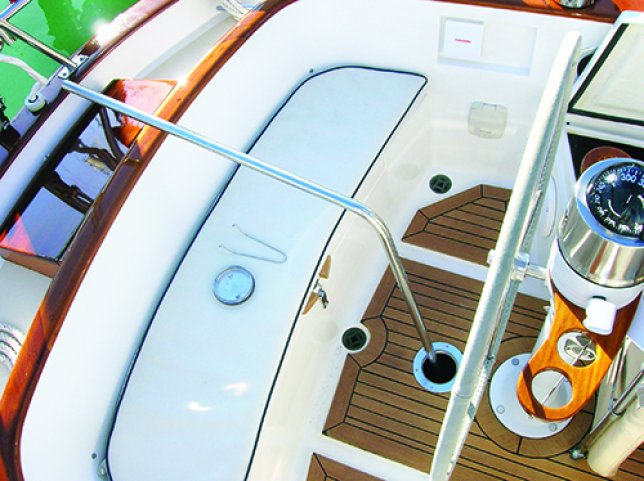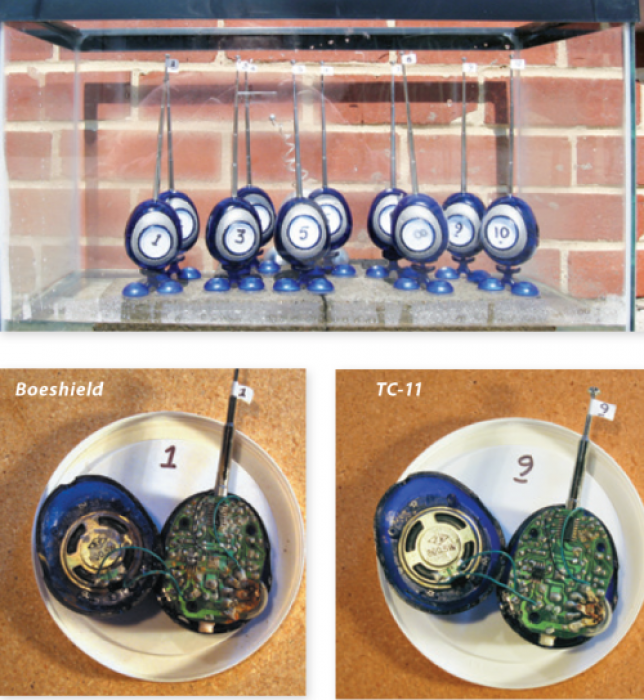Florida is hard on boats from sun damage, mildew, bottom blisters and birds. I keep the ospreys from perching on my tricolor light by fitting a clear plastic container over it with tacks on its bottom. I have sunbrella deck covers that keep poo from the smaller birds off the deck and also shade the boat to keep it cooler, the paint protected and mildew free. Then, for the pelicans that pooped on my lazarette, a crisscross of line.
Susan Clair and Donald Haynie
Bristol 40
St. Petersburg, FL
Solvent safety
In the conclusion section of the solvent article (see PS November 2019) there is a recommendation to read the MSDS and spec sheets. The two pictures accompanying the article illustrate that your users of said products didnt. Most, if not all, solvents should only be used with respiratory and contact protection-vapor masks and impermeable gloves. Practical Sailor should ensure that its photo illustrations reflect the attention paid to reviewing all things nautical.
Jim Kelly
SV Bright Moments
Musket Cove, Fiji

It is bad form to give readers the wrong impression regarding the proper care and use of solvents. Regarding the photos, the exposure levels were below those recommended for respirators in the MSDS. Going gloveless risked little exposure since we were just dabbing it on. Nevertheless, we have a responsibility to model safe practices. For more on boatyard safety, Darrell Nicholsons editorial, Staying Safe in the Boatyard, April 2018 offers a good entry point into related reporting.
Steering Inspection
Regarding your recent blog post, Steering Equipment Inspection, under cockpit autohelm motors drive the quadrant directly and the control unit can be used to steer the boat should the cables or any of its components fail. This may not be precise enough for pulling into a slip, but should be adequate for pulling close to an outside dock.
Norris Larson
Easy Reach, Pearson 424
Waukegan, Illinois
What About GPS Antenna?
With regards to your recent article on AIS and VHF antennas (see Special Report: How to Prevent AIS and VHF Antenna Malfunction, PS February 2019). I know this article focused on the radio side of AIS antennas but what about the GPS side? A friend and I have agreed to disagree on this topic. I purchased an app for my phone that tells me GPS signal strength. Where I sail in the Pacific Northwest I get basically the same strength below deck where I mounted my antenna as I get above deck – with lots of strong signals being received. He contends it needs to have a open view of the sky (he mounted it under the dodger next to a support tube). He contends my installation is not safe.
Leslie Troyer
Mahalo, Catalina 36 Mk1
Everett, WA
GPS receiver sensitivity below decks will vary by boat and by the type of GPS you have. Newer GPS units are more likely to strongly receive satellite signals below decks, although most manufacturers recommend an external antenna for even better reception and accuracy at slow speeds. Assuming it works well, there is nothing patently unsafe about using a GPS antenna below decks, and this may prevent failure due to exposure. However, a rugged marine antenna installed where it can be easily inspected is the standard offshore.
Chlorine in Water
I was very interested to read about the bad effects bleach can have on your holding tank in even in very small concentrations. I have been trying to avoid holding tank odors by encouraging good bacteria to grow. I flush a tablespoon of Zaal NoFlex Digestor down the head once a day in the pursuit of that end. I have a VacuFlush head and it uses fresh water from the house tank for flushing. The house tank is usually filled from a city water supply that is chlorinated. I have test strips and the free chlorine content of the city water is usually about 0.5 parts per million (ppm). On being advised that the chlorine (or sometimes chloramine, for the technical) gases out of the water after a few days, I decided to check the tank water and did find that the chlorine does go to zero after a week or so. So I add a one teaspoon of bleach per 10 gallons of water as and when needed to bring the chlorine up to the World Heath Organization recommendation of 0.5 ppm. Note that the WHO recommends to make the test after waiting 24 hours. Is the chlorine in tap water, or the bleach I add as needed, sabotaging my efforts to grow good aerobic bacteria in the holding tank?
Todd Thackray
Wings, Pacific Seacraft PH 32
Puget Sound, WA
The amount of bleach/chlorine is so small that it is consumed instantly on contact with the waste. A report in PS July 2015 discusses onboard water purification in great detail.
Lemon Oil for Mildew
Regarding your recent blog post Homemade Mildew Preventers That Really Work, what works spectacularly on wood is lemon oil. Not only does it enrich and feed the wood and smell good, it completely gets rid of the smell an it keeps the mildew from coming back for months.
David Mendels
Via PS Online
Lemon was also recommended for various uses in PS May 2009 report Eco-friendly Boat Maintenance.
Webbing for Sailors
Im very interested in how you reduced the diameter of your furling line converting the first 15 feet [of the furling line] to webbing. I assume this means the rest of it remained rope, probably double braid? But how to you join webbing to rope such that the join will run through the furling line blocks? Can you splice or stitch the webbing to double braid? Do have to replace the blocks with much bigger ones?
Eric Peterson
via PS Online
The webbing-to-rope splice can be done several ways, including the Facnor adapter shown in the article and several sewn splices-often covered with heat shrink tubing or whipping. Our favorite method, however, is to strip the core from the forward portion of the furler line, after which it flattens on the spool a like webbing.
Try Fluid Film
Regarding your recent blog post, In Search of the Magic Spray, many of these products work well, but leave oily residue. I found a rust inhibitor product used by farmers, Fluid Film, that is lanolin-based Ive been trying on my vehicles for two years that seems to work well and can be used on anything. The product may be found at Napa stores or can be ordered online.
Robert Bagley
Spindrift 17
Upper Peninsula, Michigan
Caution with Cellosolve
Regarding your recent blog post, Making Sense of Solvents, one of the products mentioned, cellosolve, was Union Carbides trade name for ethylene glycol mono-ethyl ether (I know- a mouthful), but also for a range of glycol ethers- methyl-, ethyl- and butyl- were the most common. It is important to note that the methyl- and ethyl- are strong reproductive toxins- hazardous to both fertility and the unborn. The EU has recommended essentially banning from the European market. The butyl- derivative is much less toxic and used in household cleaners, but still far from harmless. Usually noted on labels as ethylene glycol monobutyl ether. Other …. glycol ethers are even less toxic, but with varying solvency, water miscibility, and evaporation rate. If you have an old container that states just Cellosolve, I suggest only using it while you are upwind in a moderate gale with no one to leeward. I would add: VM&P naphtha (used for cleanup of varnish, oil paints, etc.) is faster evaporating than mineral spirits and no residual odor. Denatured ethyl alcohol is good if you will be working with polar resins (shellac, etc.).
Also, MEK (methyl ethyl ketone) is almost as universal a solvent as acetone, but much lower skin absorption and a bit slower evaporating, so it doesn’t flash off before youre finished cleaning. However, MEK is not water-miscible, which acetone is. All of these solvents have varying degrees of toxicity and all are very flammable, so store carefully and keep well away from heat, sparks, and flame. Wear gloves at all times!
Alfred Voskia
Via PS Online
Vinegar and Epoxy Warning
Regarding your recent article, Four Solvents for Nearly Every Job, vinegar reacts with the amine hardener to form a salt. This stops the cure of the epoxy-amine. Its not so much a solvent but it does prevent the viscosity of the epoxy from increasing. As for solvents, acetone will work with most epoxies. Take care though, since acetone is easily absorbed into the skin and tends to draw the other chemicals in with it. You might get away with denatured alcohol but 90 percent rubbing alcohol (isopropanol) is safer.
John Lawton
via PS Online
Good point, if you use vinegar to remove epoxy from your skin (gloves and long sleeves prevent this), use only a brief scrub to reduce the tackiness, followed immediately by a soap and water wash and rinse. This will minimize the exposure time. Vinegar is definitely the fastest way to clean laminating rollers; use a wire brush and follow up with soap and water. We also like to use it to wipe down the surrounding area (but not the immediate work area) to remove any smudges we missed. Keep it away from the work, since it will stop the hardening process.
LP3 for Battery Terminals

I have used LPS 3 on battery terminals on my boats and planes for years with very good results although it does leave a heavy residue. On other items like electrical connections and places I do not want the LPS residue I use Boeshield, developed by Boeing Aircraft with good results.
Duane Woody
via PS Online
Your letter brings up fond memories of contributing editor Jeremy McGeary, (see blog post Eight Bells for Jeremy McGeary) who died last year. McGeary devised a multiphase test of anti-corrosion sprays, including a test that immersed FM radios that we nicknamed Herbies in salt water. In that test, Boeshield was a recommended products. We did not test LPS-1, but the thinner LPS-3 which was outperformed by comparable products.

































